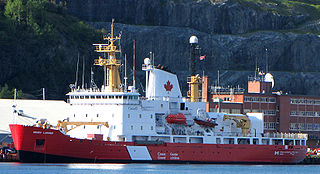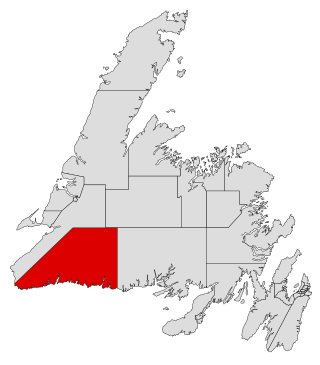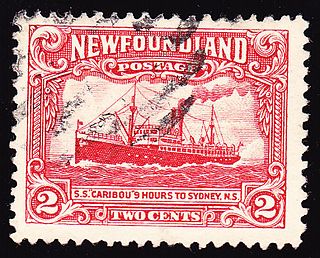
Marine Atlantic Inc. is an independent Canadian federal Crown corporation which is mandated to operate ferry services between the provinces of Newfoundland and Labrador and Nova Scotia.

Channel-Port aux Basques is a town at the extreme southwestern tip of Newfoundland fronting on the western end of the Cabot Strait. A Marine Atlantic ferry terminal is located in the town which is the primary entry point onto the island of Newfoundland and the western terminus of the Newfoundland and Labrador Route 1 in the province. The town was incorporated in 1945 and its population in the 2021 census was 3,547.

CN Marine was a Canadian ferry company headquartered in Moncton, New Brunswick.

The Newfoundland Railway operated on the island of Newfoundland from 1898 to 1988. With a total track length of 906 miles (1,458 km), it was the longest 3 ft 6 in narrow-gauge railway system in North America.

CCGS Henry Larsen is a Canadian Coast Guard Improved Pierre Radisson-class icebreaker serving in the Newfoundland and Labrador region and based in St John's, Newfoundland and Labrador. Entering service in 1988, Henry Larsen is the fourth ship and of an improved design over the rest of the ships in her class. The ship operates in the Arctic Ocean during summer months.
Terra Transport (TT) was the name for the Newfoundland Transportation Division, a wholly owned subsidiary of Canadian National Railway (CN), created in 1979 as a means to organize the company's operations on Newfoundland.
Red Bay is a fishing village in Labrador, notable as one of the most precious underwater archaeological sites in the Americas. Between 1530 and the early 17th century, it was a major Basque whaling area. Several whaling ships, both large galleons and small chalupas, sank there, and their discovery led to the designation of Red Bay in 2013 as a UNESCO World Heritage Site.

Burgeo-La Poile is a provincial electoral district for the House of Assembly of Newfoundland and Labrador, Canada. As of 2011, there are 7,527 eligible voters living within the district. The district was first created when Newfoundland joined confederation in 1949 as Burgeo and La Poile, and existed until 1975. It was recreated in 1995 following a reduction in the number of seats in the House of Assembly from 52 to 48, forming from the amalgamation of the former districts of La Poile and Burgeo-Bay D'Espoir.

MV Joseph and Clara Smallwood was a Marine Atlantic passenger/vehicle ferry which operated between Newfoundland and Cape Breton Island in eastern Canada. She is named after former Newfoundland premier Joseph R. Smallwood and his wife Clara.

MV Caribou was a Marine Atlantic passenger/vehicle ferry which operated between the islands of Newfoundland and Cape Breton in eastern Canada.

USS Edisto (AGB-2) was a Wind-class icebreaker in the service of the United States Navy and was later transferred to the United States Coast Guard as USCGC Edisto (WAGB-284). She was named after Edisto Island, South Carolina. The island is named after the Native American Edisto Band who inhabited the island and the surrounding area. As of 2011 there is a namesake cutter USCGC Edisto (WPB-1313). The newer Edisto is a 110-foot Island-class patrol boat and is stationed in San Diego County, California.

SS Caribou was a Newfoundland Railway passenger ferry that ran between Port aux Basques, in the Dominion of Newfoundland, and North Sydney, Nova Scotia between 1928 and 1942. During the Battle of the St. Lawrence the ferry participated in thrice-weekly convoys between Nova Scotia and Newfoundland. A German submarine attacked the convoy on 14 October 1942 and Caribou was sunk. She had women and children on board, and many of them were among the 137 who died. Her sinking, and large death toll, made it clear that the war had really arrived on Canada's and Newfoundland's home front. Her sinking is cited by many historians as the most significant sinking in Canadian-controlled waters during the Second World War.

Isle aux Morts is a small town on the Southwest Coast of the Island of Newfoundland, with a population of 559 (2021). The town is located approximately 16 km (9.9 mi) east from the Marine Atlantic Ferry Terminal in Port aux Basques along Route 470.

Rose Blanche – Harbour le Cou is a small town on Newfoundland's southwest shore, about 45 km at the end of Route 470 from Port aux Basques. This community is located in a barren area on the east side of a small bay. In this bay there are 2 harbours that were mainly used to provide shelter for fishing vessels. Scenery includes the rugged granite coastline, and the white and rocky cliffs of "Diamond Cove". Its granite lighthouse was in operation from 1873 to the 1940s. After it was abandoned in the 1940s the building fell into ruins. The spiral stone staircase extends into the tower wall and kept the tower from collapsing while the remainder of the lighthouse fell to ruin. In 1999 the lighthouse was fully reconstructed and serves as a tourist attraction.

MV Atlantic Vision is a fast ro-pax ferry owned by the Estonian ferry company Tallink, under charter to Canadian operator Marine Atlantic. In February 2015, Marine Atlantic announced that the lease on the vessel had been renewed until November 2017 for a cost of Can$40 million. It was subsequently extended again, and the vessel is under Marine Atlantic control through November 2019. As of 2016 Atlantic Vision operates on Marine Atlantic's services between North Sydney, Nova Scotia, and the Newfoundland ports of Channel-Port aux Basques and Argentia, Placentia.

Burnt Islands is a small coastal community found in God Bay on the southwest coast of Newfoundland, Canada.
The Alphabet Fleet was a fleet of vessels owned and operated by the Reid Newfoundland Company as part of the provisioning of the 1898 Railway contract between the Dominion of Newfoundland and the Reid Newfoundland Company. The vessels were named after places in Scotland, the native homeland of Sir Robert Gillespie Reid, founder of the Reid Newfoundland Company.

SS Kyle is a 220 feet (67 m) steam ship that is aground in the harbour of the Town of Harbour Grace, Newfoundland and Labrador, Canada. She ran ashore in February 1967. Intended to transport supplies and provide transportation from Carbonear to Labrador, she was also used to transport infantry to Canada during World War II. After her grounding on the shores of Riverhead, Harbour Grace, she has had several owners, from the Earle Brothers Freighting Company, Dominion Metals, and the Government of Newfoundland. Plans to have the vessel moved to the town of Salmon Cove, Newfoundland, and turned into a museum were later aborted due to financial implications.

MV Blue Puttees is a Ro-Pax passenger/vehicle ferry operated by Marine Atlantic between the islands of Newfoundland and Cape Breton in eastern Canada. She is named after the nickname of the Royal Newfoundland Regiment.

Route 470, also known as La Poile Highway, is a highway on the West Coast of the Canadian province of Newfoundland and Labrador. It is the last provincial highway off Route 1 before approaching the Marine Atlantic Ferry to Nova Scotia, in Channel-Port aux Basques. The route is 42.8 kilometres (26.6 mi) in length. During much of the journey, there is plenty of barren land on both sides of the road, until arriving at its final community, Rose Blanche. Route 470 also carries the designation of Granite Coast Scenic Drive.

















